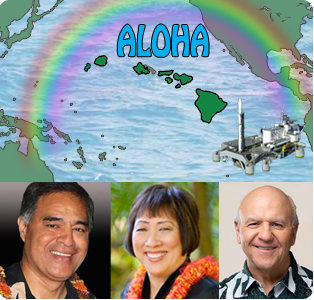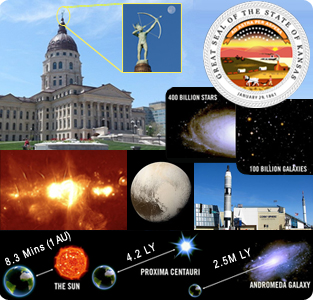Pacific Space Access Vital for Hawai’i 21st Century Resiliency
|
MONDAY Highlights…
|

![]() = All times
= All times
for terrestrial events in local time unless noted.
![]() = All times for international terrestrial events in local time unless noted.
= All times for international terrestrial events in local time unless noted.
![]() = All times for space events, and…
= All times for space events, and…
![]() = All times for international space / astro events in Hawaii Standard Time unless noted. Add 10 hours to obtain UT (‘Universal Time’).
= All times for international space / astro events in Hawaii Standard Time unless noted. Add 10 hours to obtain UT (‘Universal Time’).
Weekly Planet Watch – Evening Planets: Mars (S), Jupiter (SE), Saturn (SE); Morning Planets: Mercury (ENE), Venus (E), Uranus (E), Neptune (S).
Interstellar University Considerations
The potential establishment of an Interstellar University (IU), a collection of rich international interstellar R&D resources, could be a timely consideration for early 2020s decade to realize the long-range vision to innovate, educate, inspire and achieve Interstellar observations, communications, transportation in the 21st Century. The Ad Astra State of Kansas, reaching its 160th anniversary of becoming the 34th Star in the USA Flag 29 January 2021, is an appealing location and time to launch a modest beginning for this important venture, planning for next the 5 years and decades beyond. With the State Motto and Seal “Ad Astra Per Aspera” and Midway USA Breadbasket / Heartland persevering, upward-looking spirit – Kansas is well suited to host IU. Perhaps first starting with an existing University Department and expanding to a regular curriculum, IU would build upon in-state resources such as K-State, KU, WSU, Ad Astra Kansas Foundation, Cosmosphere housing >13K spaceflight artifacts, 7 Observatories, manufacturing / engineering capabilities and its history of aero- and astronautics with Mercury & Apollo. IU may be similar to International Space University, and see participation from the Interstellar Community including: Centauri Dreams, Tau Zero Foundation, Tennessee Valley Interstellar Workshop, 100-Year Starship, Icarus Interstellar, Starship Congress, Initiative for Interstellar Studies and Breakthrough Initiatives. Galaxy Forum Kansas 2020 Hutchinson is postponed from August to October 24, when its organizers hope an in-person / hybrid online event can support Interstellar / IU interactions and advances. (Image Credits: KS Historical Society, NASA, Cosmosphere, MeerKAT, SARAO) |
Continued From…
TUESDAY
|
WEDNESDAY
![]() Aug 5 — Curiosity, Mars Surface: Curiosity (Mars Science Laboratory) rover reaches 8 full years / enters 9th year of operations on Mars surface today; launched Nov 26, 2011 – landed Aug 5, 2012 (Pacific Daylight Time).
Aug 5 — Curiosity, Mars Surface: Curiosity (Mars Science Laboratory) rover reaches 8 full years / enters 9th year of operations on Mars surface today; launched Nov 26, 2011 – landed Aug 5, 2012 (Pacific Daylight Time).
![]() Aug 5 — Juno, Jupiter Orbit: Total distance traveled by Juno including orbits around Jupiter estimated to be 22.66 AU (3.39B km).
Aug 5 — Juno, Jupiter Orbit: Total distance traveled by Juno including orbits around Jupiter estimated to be 22.66 AU (3.39B km).
![]() Aug 5 — Space Court Foundation, Online / Sharon PA: Webinar: Visible Footsteps – Space-based observations of human impacts on Earth; by David Grinspoon, astrobiologist and award-winning author, 21:00 CET.
Aug 5 — Space Court Foundation, Online / Sharon PA: Webinar: Visible Footsteps – Space-based observations of human impacts on Earth; by David Grinspoon, astrobiologist and award-winning author, 21:00 CET.
![]() Aug 5-7 — Lunar and Planetary Institute, Universities Space Research Association, University of Hawaiˋi – Manoa, Online: 11th Planetary Crater Consortium (PCC) Virtual Meeting.
Aug 5-7 — Lunar and Planetary Institute, Universities Space Research Association, University of Hawaiˋi – Manoa, Online: 11th Planetary Crater Consortium (PCC) Virtual Meeting.
![]() Aug 5 — Mercury: At perihelion (distance 0.3075 AU from Sun), 18:00.
Aug 5 — Mercury: At perihelion (distance 0.3075 AU from Sun), 18:00.
![]() Aug 5 — Apollo Asteroid 2009 PQ1: Near-Earth Flyby (0.028 AU)
Aug 5 — Apollo Asteroid 2009 PQ1: Near-Earth Flyby (0.028 AU)
THURSDAY
![]() Aug 6 — Roscosmos State Corporation, Launch Soyuz / Glonass K, Plesetsk Cosmodrome, Russia: Soyuz rocket to launch Glonass K navigation satellite.
Aug 6 — Roscosmos State Corporation, Launch Soyuz / Glonass K, Plesetsk Cosmodrome, Russia: Soyuz rocket to launch Glonass K navigation satellite.
![]() Aug 6 — SpaceX, Launch Falcon 9 / Starlink 9 / BlackSky Global, LC-39A KSC FL: SpaceX to launch 10th batch of ~60 satellites for Starlink broadband network and 2 Earth observation microsatellites for BlackSky Global; launch 01:33 EDT.
Aug 6 — SpaceX, Launch Falcon 9 / Starlink 9 / BlackSky Global, LC-39A KSC FL: SpaceX to launch 10th batch of ~60 satellites for Starlink broadband network and 2 Earth observation microsatellites for BlackSky Global; launch 01:33 EDT.
![]() Aug 6 — Space Tourism Society, Online / Los Angeles CA: Space Tourism Conference Webinar Series: Follow the Money.
Aug 6 — Space Tourism Society, Online / Los Angeles CA: Space Tourism Conference Webinar Series: Follow the Money.
![]() Aug 6 — Moon Village Association, Online / Vienna, Austria: Webinar: Governance of Global Moon Exploration and Settlement; featuring Mike Gold (NASA), Marius Piso (Romanian Space Agency), Mark Sundahl (Cleveland State Univ), George Danos (Cyprus Space Exploration Org), Giuseppe Reibaldi (MVA); 16:00 CEST.
Aug 6 — Moon Village Association, Online / Vienna, Austria: Webinar: Governance of Global Moon Exploration and Settlement; featuring Mike Gold (NASA), Marius Piso (Romanian Space Agency), Mark Sundahl (Cleveland State Univ), George Danos (Cyprus Space Exploration Org), Giuseppe Reibaldi (MVA); 16:00 CEST.
![]() Aug 6 — W. M. Keck Observatory, Online: Lecture: The NIRSPEC Upgrade for Keck Observatory – Enhancing Observations from the Solar System to Exoplanets and Beyond; by Emily Martin, National Science Foundation Astronomy and Astrophysics Fellow from University of California – Santa Cruz, 17:00-18:30.
Aug 6 — W. M. Keck Observatory, Online: Lecture: The NIRSPEC Upgrade for Keck Observatory – Enhancing Observations from the Solar System to Exoplanets and Beyond; by Emily Martin, National Science Foundation Astronomy and Astrophysics Fellow from University of California – Santa Cruz, 17:00-18:30.
![]() Aug 6 — Moon: 4.0° SE of Neptune, 09:00.
Aug 6 — Moon: 4.0° SE of Neptune, 09:00.
FRIDAY
![]() Aug 7-9 — International Space University, Online / Strasbourg, Germany: ISU Alumni Conference.
Aug 7-9 — International Space University, Online / Strasbourg, Germany: ISU Alumni Conference.
SATURDAY
![]() Aug 8 — Ad Astra Kansas Foundation, Space Age Publishing Company, ILOA, Hutchinson KS: Galaxy Forum Kansas 2020 Hutchinson; Conference postponed to October 24.
Aug 8 — Ad Astra Kansas Foundation, Space Age Publishing Company, ILOA, Hutchinson KS: Galaxy Forum Kansas 2020 Hutchinson; Conference postponed to October 24.
![]() Aug 8 — Moon: 0.71° SE of Mars, 23:00.
Aug 8 — Moon: 0.71° SE of Mars, 23:00.
![]() Aug 8 — Mercury: 0.06° SE of Beehive Cluster, 15:00.
Aug 8 — Mercury: 0.06° SE of Beehive Cluster, 15:00.
![]() Aug 8 — Apollo Asteroid 2020 OL4: Near-Earth Flyby (0.024 AU)
Aug 8 — Apollo Asteroid 2020 OL4: Near-Earth Flyby (0.024 AU)
SUNDAY
![]() Aug 9 — SpaceBase, Christchurch, New Zealand: Moon Exhibition: Our Moon, Then, Now and Beyond.
Aug 9 — SpaceBase, Christchurch, New Zealand: Moon Exhibition: Our Moon, Then, Now and Beyond.
![]() Aug 9-12 — AAS Space Flight Mechanics Committee, AIAA Astrodynamics Technical Committee, Online / South Lake Tahoe CA: 2020 AAS/AIAA Astrodynamics Specialist Conference; featuring Artemis Program Special Session.
Aug 9-12 — AAS Space Flight Mechanics Committee, AIAA Astrodynamics Technical Committee, Online / South Lake Tahoe CA: 2020 AAS/AIAA Astrodynamics Specialist Conference; featuring Artemis Program Special Session.
![]() Aug 9 — Moon: At apogee (distance 404,684 km), 04:00.
Aug 9 — Moon: At apogee (distance 404,684 km), 04:00.

